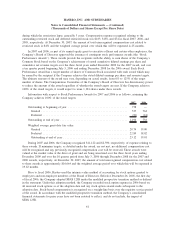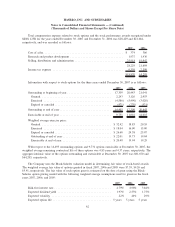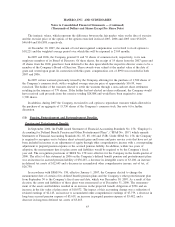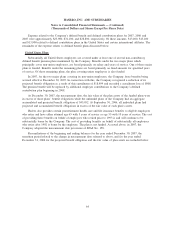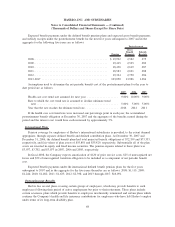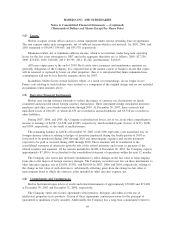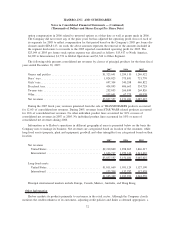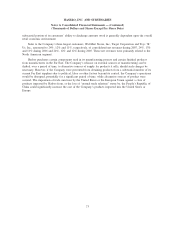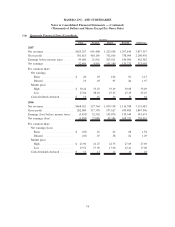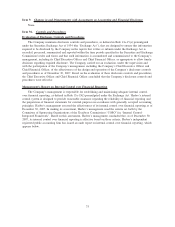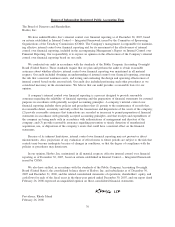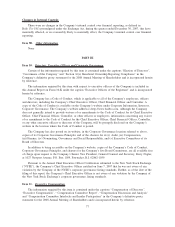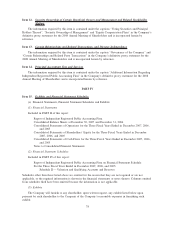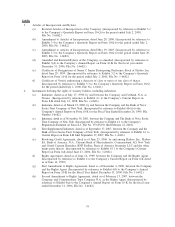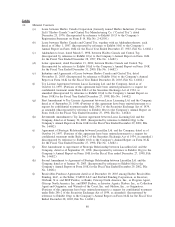Hasbro 2007 Annual Report Download - page 78
Download and view the complete annual report
Please find page 78 of the 2007 Hasbro annual report below. You can navigate through the pages in the report by either clicking on the pages listed below, or by using the keyword search tool below to find specific information within the annual report.
promotional and marketing activities at a U.S. based theme park. Under terms of existing agreements as of
December 30, 2007, Hasbro may, provided the other party meets their contractual commitment, be required to
pay amounts as follows: 2008: $18,354; 2009: $19,691; 2010: $44,645; and 2011: $5,125.
In addition to the above commitments, certain of the above contracts impose minimum marketing
commitments on the Company.
The Company has $94,616 of prepaid royalties included as a component of prepaid expenses and other
current assets in the balance sheet. The long-term portion of advances paid of $43,343 is included in other
assets. Advanced royalties paid and guaranteed or minimum royalties to be paid relate to anticipated revenues
in the years 2008 through 2018.
At December 30, 2007, the Company had approximately $249,883 in outstanding purchase commitments.
Hasbro is party to certain legal proceedings, none of which, individually or in the aggregate, is deemed to
be material to the financial condition of the Company.
(15) Segment Reporting
Segment and Geographic Information
The Company has two main operating segments, North America and International. In addition, the
Company has two other segments, Global Operations and an other segment that licenses out certain toy and
game properties.
The North American segment includes the development, marketing and selling of boys’ action figures,
vehicles and playsets, girls’ toys, electronic toys and games, plush products, preschool toys and infant
products, electronic interactive products, tween electronic products, toy-related specialty products, traditional
board games and puzzles, DVD- based games, fiction books, and trading card and role-playing games within
the United States, Canada and Mexico. Within the International segment, the Company develops, markets and
sells both toy and certain game products in non-North American markets, primarily the European, Asia
Pacific, and Latin and South American regions. The Global Operations segment is responsible for manufactur-
ing and sourcing finished product for the Company’s North American and International segments. The
Company’s other segment licenses out certain toy and game properties.
Segment performance is measured at the operating profit level. Included in Corporate and eliminations
are certain corporate expenses, the elimination of intersegment transactions and certain assets benefiting more
than one segment. Intersegment sales and transfers are reflected in management reports at amounts
approximating cost. Certain shared costs are allocated to segments based upon foreign exchange rates fixed at
the beginning of the year, with adjustment to actual foreign exchange rates included in Corporate and
eliminations.
In 2006 the Company adopted SFAS 123R, which requires the Company to record expense related to
stock options in its consolidated financial statements. Consistent with management’s approach in evaluating
segment results, the 2005 segment operating profit (loss) has been adjusted to include stock-based compensa-
tion as disclosed under SFAS 123. The amount of 2005 stock option expense is subtracted from the total
segment operating profit (loss) in order to reconcile to the operating profit in the consolidated financial
statements.
With the exception of the treatment of stock-based compensation expense for 2005 management financial
statements, the accounting policies of the segments are the same as those referenced in Note 1.
Results shown for fiscal years 2007, 2006 and 2005 are not necessarily those which would be achieved
were each segment an unaffiliated business enterprise.
70
HASBRO, INC. AND SUBSIDIARIES
Notes to Consolidated Financial Statements — (Continued)
(Thousands of Dollars and Shares Except Per Share Data)



